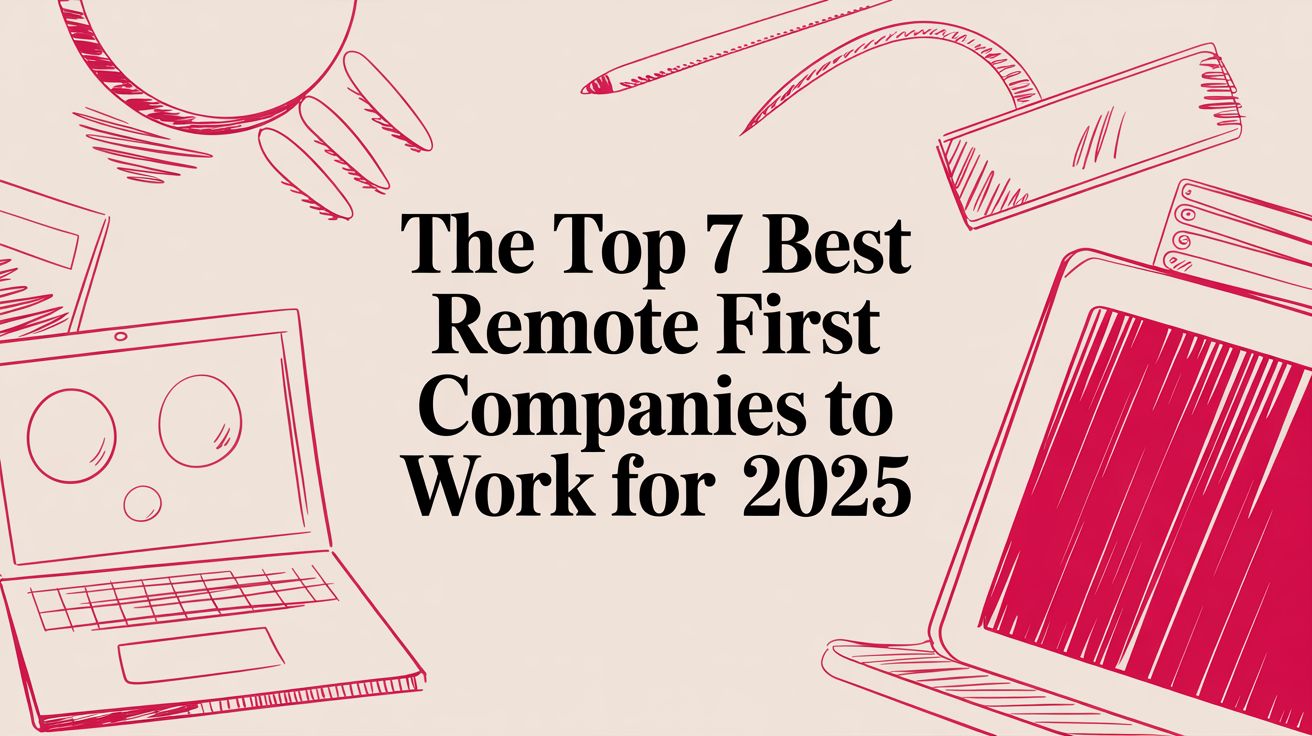How to Improve Employee Retention: Practical Strategies for Success
Max
Improving employee retention isn’t just about throwing a pizza party and hoping for the best. It’s about getting to the root of why your best people are walking out the door and fixing those problems before they even think about leaving. You have to shift from being reactive to building a place where your top talent actually wants to stick around.
Why Your Best People Are Quietly Leaving
Let’s be clear: employee retention is no longer some fuzzy HR metric you glance at in a quarterly report. It’s a direct reflection of your company’s health and a core business strategy. When you lose someone good, the ripple effects go way beyond recruitment fees. You’re bleeding institutional knowledge, killing team momentum, and frankly, damaging the morale of everyone who stays behind.
This isn’t just a hypothetical problem; it’s a massive business challenge. A recent workforce trends report found that a staggering 66% of HR executives see retention as their single biggest hurdle. It’s not just HR feeling the pain, either—over half of operations leaders said turnover was their number one obstacle. The data is screaming at us: failing to keep your people means failing to perform. You can dig into more of these insights on how turnover impacts the C-Suite in this report.
The Hidden Costs of High Turnover
The sticker shock of replacing an employee is bad enough—estimates often land somewhere between one-half to two times their annual salary. But the real cost is so much deeper and more disruptive.
Think about the drains on your business that don’t show up on a spreadsheet:
- Productivity craters: A vacant role means work isn’t getting done, or worse, it’s being piled onto your already swamped team members. Burnout, anyone? Then, the new hire needs months just to get up to speed.
- The brain drain: When a veteran employee leaves, they take years of experience, customer relationships, and nuanced process knowledge with them. You can’t just replace that with a job posting.
- Morale nosedives: High turnover creates a vibe of instability. The people who stay start feeling overworked, disengaged, and begin wondering, “Should I be looking, too?”
Understanding the Great Detachment
Ever been blindsided by a resignation from a top performer? They seemed happy, hit all their targets, never complained. This is what some call ‘The Great Detachment’—when employees are physically at their desks (or logged in from home) but have mentally and emotionally checked out.
The real danger isn’t the employee who complains; it’s the one who has gone silent. Disengagement is the quiet precursor to departure, and by the time you notice, it’s often too late.
This detachment is a symptom of bigger problems bubbling under the surface. Maybe they feel undervalued, see no clear path for advancement, or just don’t feel connected to the company’s mission anymore. Getting to the “why” behind these quiet departures is the first, most critical step in building a team that doesn’t just stay, but actually thrives.
Build a Culture People Never Want to Leave

So many leaders fall into the trap of thinking a long list of benefits and a fully-stocked snack kitchen are what keep people around. While perks are nice, they don’t inspire deep loyalty. The real secret to keeping your best people is building a magnetic culture—one where your team feels a genuine sense of belonging and psychological safety.
This isn’t just a feel-good idea; it’s a powerful strategic advantage. Research from the O.C. Tanner Institute’s Global Culture Report found that companies obsessed with massive benefit catalogs often miss the mark. To truly hang on to top talent, you have to meet fundamental human needs by creating an environment where employees can thrive, not just survive. You can dig into why an inclusive culture is the strongest retention driver in their full report.
Fostering Psychological Safety
Psychological safety is the absolute bedrock of a culture built for retention. It’s that shared belief that anyone on the team can take risks, speak up, or even mess up without getting punished for it. When people feel safe, they’re far more likely to voice new ideas, admit when they’ve made a mistake, and ask for help—all the things that actually drive innovation and engagement.
So, how do you build it? It starts at the top. When a manager openly admits they don’t have all the answers or shares a lesson learned from a past failure, it sends a powerful signal to the team that vulnerability isn’t a weakness.
When employees feel safe enough to be authentic, they stop wasting energy on self-protection and start investing it in their work. This shift from fear to focus is where high-performing, loyal teams are born.
Another practical step is to completely reframe how your team talks about failure. Instead of asking, “Whose fault is this?” when something goes wrong, try asking, “What can we learn from this?” This simple shift in language moves the focus from blame to growth, encouraging accountability without creating a culture of fear.
Cultivating a Sense of Belonging
Beyond safety, people need to feel like they truly belong. Belonging is that feeling of being seen, accepted, and valued for who you are. It’s the difference between being invited to the party and being asked to dance.
Creating this requires real intention. It goes way beyond celebrating holidays or running one-off diversity workshops. It’s about weaving inclusivity into your daily operations.
For example, during meetings, make it a habit to actively ask for opinions from the quieter people on the team. A simple phrase like, “Sarah, we haven’t heard from you yet—what are your thoughts on this?” can make a huge difference. You can find more tips like this in our guide on boosting remote employee engagement.
True belonging also sprouts from connection. Encourage non-work-related chats and hangouts, even when you’re fully remote. Things like virtual coffee breaks or Slack channels dedicated to hobbies create spaces for personal connections that strengthen professional bonds.
When colleagues feel like genuine friends, the thought of leaving becomes that much harder. It transforms a job from a simple transaction into a meaningful part of their life.
Create Career Paths That Inspire Growth

Let’s be honest: top performers don’t leave jobs they love. They leave jobs with no future. If your best people look ahead and see a dead end instead of a clear path forward, they’ll start searching for a new road—one that leads out your door.
One of the most powerful retention strategies you have is building visible, exciting career pathways. It’s about showing your team you’re invested in their long-term success. This isn’t about dusting off the old corporate ladder, where the only way up is a direct promotion. Modern growth is far more dynamic.
We’re talking about creating opportunities for lateral moves to build new skills, assigning challenging projects that stretch an employee’s capabilities, and genuinely fostering a culture of continuous learning. The data backs this up: a staggering 94% of employees say they would stay at a company longer if it invested in their development. Growth is a retention magnet.
Designing Modern Growth Trajectories
The rigid, traditional career ladder just doesn’t cut it for today’s workforce. To keep ambitious talent engaged, you need to offer diverse ways for them to advance. This approach isn’t just a morale booster; it builds a more agile and skilled team across the board.
A fantastic model to consider is the dual-track career path. This gives employees a choice to grow as either an individual contributor or a people manager.
With a dual-track system, your brilliant senior engineer doesn’t have to become a manager just to get a raise and more influence. They can advance to roles like “Principal Engineer” or “Architect,” gaining seniority and compensation that’s on par with a director-level manager. This simple structure prevents you from losing top technical talent or forcing them into management roles they aren’t suited for (and probably don’t want).
People are far more likely to stay and grow with a company that values their unique talents, rather than forcing them into a one-size-fits-all career box. The goal is to build a jungle gym of opportunities, not just a ladder.
To illustrate, let’s look at how a modern approach revitalizes the key components of a career development program.
Key Components of a Modern Career Growth Program
This table breaks down the shift from outdated career models to strategies that actually drive retention in a remote-first world.
| Component | Traditional Approach | Modern Retention-Focused Approach |
|---|---|---|
| Pathways | A single, linear “corporate ladder” for promotions. | A “jungle gym” with dual-track (IC/Manager), lateral, and project-based growth opportunities. |
| Skill Development | Occasional, generic training workshops. | Personalized learning stipends, mentorship programs, and on-the-job stretch assignments. |
| Conversations | Annual performance review focused on past results. | Quarterly, forward-looking career conversations focused on aspirations and goals. |
| Transparency | Vague promotion criteria and timelines. | Clearly documented skill matrices and competencies required for each level. |
| Ownership | Manager-driven, top-down process. | Employee-owned development plans, supported and co-created with their manager. |
By adopting these modern approaches, you create a system where employees feel seen, valued, and empowered to build a meaningful future within your company.
The Power of Career Conversations
Mapping out potential career paths is only half the battle. You have to bring these possibilities to life through regular, honest conversations about career growth.
And to be clear, these are not performance reviews. They are forward-looking discussions focused entirely on an employee’s aspirations and how the company can help them get there. These conversations should feel like a positive, integral part of the employee journey, right from the beginning. To get this right from day one, it’s crucial to know how to https://remotefirstjobs.com/blog/improve-candidate-experience and set clear expectations from the start.
A manager might open a conversation by saying, “You’ve absolutely crushed it on project management this quarter. Are you interested in pursuing a certification, or would you rather lead a small cross-functional initiative to build more leadership skills?”
That simple question shows a genuine investment in their future. You can find more strategies for career alignment and retention that dig deeper into fostering this kind of professional development. When people see a tangible future with you, they’re motivated to stick around and build it together.
Mastering Feedback and Recognition That Works

Feeling unheard or unappreciated is one of the fastest ways to push a great employee right out the door. A lot of companies have some sort of feedback or recognition program, but they often miss the mark, feeling more like a corporate checklist than a real effort to value people. Getting this right is a cornerstone of employee retention.
The data here is startling: a sobering 66% of employees say they would likely quit their job if they felt unappreciated. That’s not a small number—it’s a massive opportunity for companies willing to build a better way. The goal is to create systems that feel genuine, timely, and woven into your daily culture.
Building a Continuous Feedback Loop
Let’s be honest: annual reviews are a relic of the past. Waiting an entire year to talk about performance is like trying to navigate a ship using last year’s map. It just doesn’t work for modern, fast-moving teams. What you really need is a continuous feedback loop that feels more like ongoing coaching than a yearly critique.
This means empowering managers to have regular, informal check-ins focused on real-time challenges and wins. It’s also about creating enough psychological safety for employees to feel comfortable sharing their own perspectives. Our guide on how to ask for feedback at work has some great, actionable steps for both sides of the conversation.
A culture of continuous feedback isn’t about constant critique; it’s about making small, consistent adjustments together. It shows employees their voice matters every day, not just once a year.
This approach transforms feedback from a dreaded event into a normal, productive part of the workflow. It builds trust and makes people feel supported in their growth, which is exactly what makes them want to stick around.
Making Recognition Resonate
Meaningful recognition goes way beyond a generic “Employee of the Month” plaque gathering dust on a shelf. The most effective programs are built on three simple principles: they are timely, specific, and authentic. A quick “thank you” for a specific action often lands with more impact than a delayed, formal award.
Think about implementing a multi-layered recognition strategy:
- Peer-to-Peer Recognition: Fire up a dedicated Slack channel where anyone can give a public shout-out to a colleague for their help. This builds a culture of gratitude from the ground up.
- Manager Spotlights: Encourage managers to highlight a specific team member’s contribution during weekly team huddles. For instance, “I want to recognize Maria for staying late to crush that critical bug—she saved our relationship with that client.”
- Value-Based Rewards: Tie small rewards—like a coffee gift card or an extra day off—to actions that directly reflect your company’s core values. This reinforces the exact behaviors you want to see more of.
When recognition is truly part of your company’s DNA, it becomes a powerful retention tool. It consistently reminds employees that their work is seen, their effort is valued, and they are essential to the team’s success. That deep sense of appreciation is what keeps your top talent invested for the long haul.
Adapt Your Retention Strategy for Any Industry

It’s tempting to grab a one-size-fits-all retention plan and hope for the best, but that’s a common mistake that almost never works. The reality is, the reasons someone leaves a tech startup are worlds apart from why they’d quit a job at a hospital or on a construction site. If you don’t get a handle on these industry-specific drivers, you’re just throwing solutions at the wrong problems.
A universal approach falls flat because it completely ignores the unique pressures, work cycles, and skill demands of different sectors. Tech companies, for example, are in a constant battle to keep top talent from being poached by competitors, all while dealing with project-based burnout. Meanwhile, the hospitality industry struggles with high turnover thanks to grueling hours, emotional labor, and often, lower pay.
To actually make a difference, you have to dig deeper than generic best practices and get to the root of the pain points in your specific field. This means looking at industry data and committing to solving the real challenges your people face every single day.
Tailoring Strategies for High-Turnover Sectors
Industries like hospitality, retail, and healthcare are always fighting high turnover, but the “why” behind it is different for each. If you ignore those nuances, you’re fighting the wrong battle. A hotel chain might struggle with seasonal work and unpredictable schedules, while a healthcare facility is dealing with burnout from high-stakes, emotionally draining work.
The data tells a clear story. One report shows travel and hospitality leading the pack with the highest turnover rates. In healthcare, an average turnover of 2.4% might not sound alarming, but it hides a massive crisis—rates jump from 19.5% in hospitals to a staggering 94% in nursing homes. That points to severe burnout and critical staffing issues.
To actually combat this, your strategies need to be razor-sharp:
- For Hospitality/Retail: Your focus should be on creating predictable schedules people can plan their lives around. Offer clear career paths so a cashier can see a future as a manager, and build recognition programs that genuinely reward amazing customer service.
- For Healthcare: Make mental health support a non-negotiable priority. Enforce manageable staff-to-patient ratios to prevent burnout and provide ongoing professional development so your team can keep their specialized skills sharp.
Adapting to Project-Based and Skill-Driven Fields
In fields like tech, engineering, and construction, retention is often tied to project cycles and the need for fresh, relevant skills. When a big project wraps up, it’s natural for talented people to feel like their work is done and start looking for the next big thing. And if they feel their skills are getting stale, they’ll definitely look for a place that offers more growth.
The key to retention in these industries isn’t just about the day-to-day culture; it’s about connecting employees to a compelling future beyond the current project or tech stack. They need to see a continuous path for impact and learning.
You have to be proactive. Before a project even ends, you should be talking to your team about what’s next. Is there another exciting project on the horizon? A chance to mentor junior developers? Dedicated time for upskilling in a new technology? By focusing on that continuous engagement and development, you build a more resilient and motivated team. Diving into performance management best practices is a great way to build a solid framework for these crucial conversations.
Successfully adapting your retention strategy also means getting the fundamentals right. Leveraging professional insights into legal assessment and effective HR management ensures your efforts are both compliant and impactful. When you understand the big picture in your sector and the small, daily experiences of your team, you can build a smarter, more resilient retention plan that actually works.
Common Questions About Employee Retention
Even with a solid game plan, leaders always have specific questions when they get serious about keeping their best people. Let’s dig into some of the most common ones I hear and offer some straight-up, actionable advice.
What Is the First Step I Should Take to Improve Employee Retention?
Before you even think about rolling out a new program or shiny new perk, you have to figure out why people are leaving in the first place. This is the most critical first step. You can’t solve a problem you don’t understand.
Start digging for the truth. Conduct thoughtful exit interviews—not just check-the-box conversations. Deploy anonymous employee surveys to get that brutally honest, unfiltered feedback you need.
Look for patterns in what people are telling you. Is compensation a recurring theme? Are people feeling stuck with no path forward? Is it a management issue? A disconnect from the culture? This diagnostic phase is non-negotiable. It ensures you’re treating the actual disease, not just the symptoms.
How Can I Improve Retention on a Limited Budget?
This is a big one. The good news is that boosting retention isn’t always about throwing money at the problem. Some of the most powerful initiatives are low-cost or even free—they’re all about culture, connection, and communication.
Here are a few budget-friendly ideas you can start with:
- Amplify Recognition: This costs nothing but time. Create a public Slack channel just for peer-to-peer shout-outs. Get managers in the habit of giving consistent, specific praise in team meetings.
- Offer Flexibility: If your business model allows for it, lean into flexible work hours or more remote options. The autonomy and trust you show by doing this are incredibly valuable to employees.
- Prioritize Career Conversations: This is huge. Managers should dedicate real time in their one-on-ones to talk about an employee’s career goals. Just showing you’re invested in their future can make a massive difference.
These kinds of culture-focused efforts often have a much bigger impact than a pricey but impersonal benefit. For a deeper look, check out these valuable strategies to reduce employee churn and keep your team engaged.
Investing time in your people is always a high-return activity. A manager who actively listens and shows they care about an employee’s growth can be more valuable than any bonus.
How Often Should We Measure Retention and Engagement?
You need to track both, but they require different cadences. Think of them as two different dials on your dashboard.
Employee retention metrics, like your turnover rate, should be monitored quarterly and annually. This gives you a high-level view to spot long-term trends and see if your big-picture strategies are actually working over time.
Employee engagement, on the other hand, is your leading indicator—it’s the pulse of your organization. This needs to be measured much more frequently.
Short, anonymous “pulse” surveys sent out monthly or even quarterly are your early warning system. They give you a real-time sense of morale and help you catch issues before they snowball into resignations. When you pair that data with the qualitative insights you get from regular one-on-ones, you get a full, clear picture of your team’s health. Many of these principles are just good remote work best practices.


